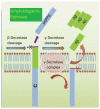CSF Biomarkers in the Early Diagnosis of Mild Cognitive Impairment and Alzheimer's Disease
- PMID: 37240322
- PMCID: PMC10218948
- DOI: 10.3390/ijms24108976
CSF Biomarkers in the Early Diagnosis of Mild Cognitive Impairment and Alzheimer's Disease
Abstract
Alzheimer's disease (AD) is a rapidly growing disease that affects millions of people worldwide, therefore there is an urgent need for its early diagnosis and treatment. A huge amount of research studies are performed on possible accurate and reliable diagnostic biomarkers of AD. Due to its direct contact with extracellular space of the brain, cerebrospinal fluid (CSF) is the most useful biological fluid reflecting molecular events in the brain. Proteins and molecules that reflect the pathogenesis of the disease, e.g., neurodegeneration, accumulation of Abeta, hyperphosphorylation of tau protein and apoptosis may be used as biomarkers. The aim of the current manuscript is to present the most commonly used CSF biomarkers for AD as well as novel biomarkers. Three CSF biomarkers, namely total tau, phospho-tau and Abeta42, are believed to have the highest diagnostic accuracy for early AD diagnosis and the ability to predict AD development in mild cognitive impairment (MCI) patients. Moreover, other biomarkers such as soluble amyloid precursor protein (APP), apoptotic proteins, secretases and inflammatory and oxidation markers are believed to have increased future prospects.
Keywords: Abeta; Alzheimer’s disease; CSF; tau.
Conflict of interest statement
The authors declare no conflict of interest.
Figures
References
-
- Dementia Statistics. Numbers of People with Dementia. Alzheimer’s Disease International. [(accessed on 27 February 2022)]. Available online: https://www.alzint.org/about/dementia-facts-figures/dementia-statistics/
-
- Farrer L.A., Cupples L.A., Haines J.L., Hyman B.T., Kukull W.A., Mayeux R., Myers R.H., Pericak-Vance M.A., Risch N., Van Duijn C.M. Effects of Age, Sex, and Ethnicity on the Association Between Apolipoprotein E Genotype and Alzheimer Disease. A meta-analysis. APOE and Alzheimer Disease Meta Analysis Consortium. JAMA. 1997;278:1349–1356. doi: 10.1001/jama.1997.03550160069041. - DOI - PubMed
-
- McKhann G.M., Knopman D.S., Chertkow H., Hyman B.T., Jack C.R., Jr., Kawas C.H., Klunk W.E., Koroshetz W.J., Manly J.J., Mayeux R., et al. The diagnosis of dementia due to Alzheimer’s disease: Recommendations from the National Institute on Aging-Alzheimer’s Association workgroups on diagnostic guidelines for Alzheimer’s disease. Alzheimer’s Dement. 2011;7:263–269. doi: 10.1016/j.jalz.2011.03.005. - DOI - PMC - PubMed
Publication types
MeSH terms
Substances
LinkOut - more resources
Full Text Sources
Medical



